109 results
Higher education astronomy lectures

Solar Eclipse Reading Comprehension Passages Bundle for All Ages:Explore, Learn!
Solar Eclipse Reading Comprehension Passages Bundle for All Ages:Explore, Learn!Solar Eclipse Educational Bundle: Explore, Learn, Eclipse! Discover the Solar Eclipse Bundle! Tailored for elementary, high school, and middle school students, this collection offers engaging reading passages and questions about the April 8th, 2024 solar eclipse. Ignite curiosity and deepen comprehension with age-appropriate materials. Explore the wonders of celestial events with our Solar Eclipse Bundle!
Subjects:
Grades:
1st - 12th, Higher Education, Adult Education
Types:
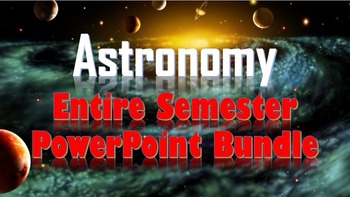
Astronomy PowerPoint Bundle
How to get TPT credit to use on future purchases:
• Please go to your My Purchases page (you may need to login). Beside each purchase you'll see a Provide Feedback button. Simply click it and you will be taken to a page where you can give a quick rating and leave a short comment for the product.
Astronomy PowerPoint Bundle
This bundle includes the following PowerPoints:
Chapter 1.1 Constellations and Numbers
Chapter 1.2.2 The Solar System and the Universe
Chapter 2.1 The Earth and the Sky
Cha
Subjects:
Grades:
7th - 12th, Higher Education

Concept Compare: Kepler's (and Newton's) Laws of Planetary Motion for Orbits
This concept comparison is between: Kepler's Laws of Planetary Motion, and how they relate to Newton's Laws of Motion and the Law of Universal Gravitation. Bring a calculator!The Concept Comparison Routine is used help compare and contrast key concepts. Specifically, students use like and unlike characteristics and categories shared and not shared by two or more concepts to better understand the overall concept. Students taught using the Content Enhancement routines earned higher total test scor
Subjects:
Grades:
7th - 12th, Higher Education
NGSS:
HS-ESS1-4
Also included in: StayGiant Earth Science Bundle: Astronomy (space exploration)

Astronomy: Special and General Relativity
Astronomy: Einstein and Relativity
PowerPoint Presentation
Topics: Einstein, Special and General Relativity, Conservation of Mass-Energy, Spacetime, Theory of Gravity, Gravitational Lensing, Black Holes, Wormholes
Subjects:
Grades:
9th - 12th, Higher Education

Study Guides for “Astronomy: A Self-Teaching Guide” (Moche): Ch. 01-07
I use Dinah Moche's popular work "Astronomy: A Self-Teaching Guide" as a textbook for my elective high school Astronomy class. While teaching Astronomy, I prepared PowerPoint slides to accompany each chapter that I use from the book. I offered these teaching slides for free as a service to the TpT community. I also created study guide handouts for chapters 01-07 of Moche’s book. The study guides can serve as “guided notes” for the PowerPoint slides. They include questions, diagrams, and vocabula
Subjects:
Grades:
10th - 12th, Higher Education
Types:
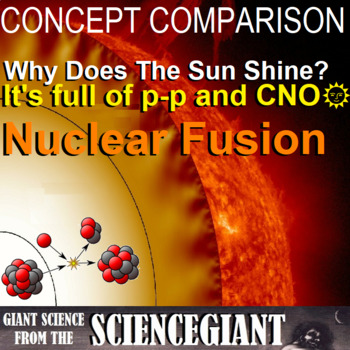
Concept Compare: Why Does the Sun Shine? Thermonuclear Fusion! (p-p and CNO)
This Concept Comparison of Thermonuclear Fusion contrasts proton-proton (p-p) chain reactions, and the "cold" carbon-nitrogen-oxygen (CNO) cycles. Help Ss communicate scientific ideas about the way stars produce elements over their life cycle. Emphasis is on the way nucleosynthesis, and therefore the different elements created, varies as a function of the mass of a star and the stage of its lifetime. As cosmologist Carl Sagan famously said, “We are made of star stuff.” And we literally are! We a
Subjects:
Grades:
8th - 12th, Higher Education
NGSS:
HS-PS1-8
, HS-ESS1-3
, HS-ESS1-1
Also included in: StayGiant Earth Science Bundle: Astronomy (space exploration)

Question Exploration: What Are the Solar Activity Sunspot Cycles?
What are the solar activity sunspot cycles? Sunspots increase and decrease through an average cycle of 11 years. This Question Exploration helps Ss explain how the spotless Sun turns dark, releasing solar flares and coronal mass ejections (CMEs).Question Exploration Routine is an instructional methods that teachers can use to help a diverse student population understand a body of content information by carefully answering a critical question to arrive at a main idea answer. The Concept Comparis
Subjects:
Grades:
7th - 12th, Higher Education
Types:
NGSS:
HS-ESS1-1

Question Explore: What Methods Measure Ultra Space Deep Distances? Parallax
This Question Exploration asks the Essential Question about cosmic distances: What Methods Do Astronomers Use to Measure Ultra Deep Space Distances? (from radar and parallax, to standard candles and Tully-Fisher Relationship used to measure distances to galaxies).Included are two activities on the scale of the universe for student assessment to be used as a warm up or after class review. The first is a classroom formation line-up, the other is a two-inch universe modeling about scale and ratios.
Subjects:
Grades:
7th - 11th, Higher Education
NGSS:
5-ESS1-1
, MS-ESS1-2
Also included in: StayGiant Earth Science Bundle: Astronomy (space exploration)

The Moons of Jupiter
This PowerPoint presentation covers the 4 main Galilean moons of Jupiter in exquisite detail. Stunning 4K and HD images along with the most up to date information make this presentation a must for any Astronomy class! From real volcanic eruptions on Io to the large ice cracks on Europa this is sure to get students engaged in your lesson.You may edit this presentation as needed.Please download the FREE follow along note sheet and check out my other free downloads.Educating the World Together!Ge
Subjects:
Grades:
6th - 12th, Higher Education

Astronomy: The Celestial Sphere
Astronomy: The Celestial Sphere
PowerPoint Presentation
Topics: Coordinate System, Meridians, Prime Meridian, Latitude and Longitude, the Celestial Sphere, Zenith, Nadir, Astronomical Horizon,, North Celestial Pole, South Celestial Pole, Celestial Equator, Celestial Meridian, Hour Angle, Declination, Motions in the Sky, Daily Paths, Circumpolar Stars, Demonstrations that the Earth Spins, Focault Pendulums, Coriolis Effect
Subjects:
Grades:
9th - 12th, Higher Education
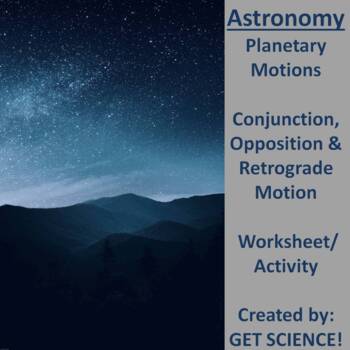
Planetary Motions: Conjunction, Opposition & Retrograde Motion
This worksheet should be used simultaneously with the free PowerPoint presentation titled "Planetary Motions". The PowerPoint walks the students through the meanings of Conjunction, Opposition and Retrograde motion. Examples, pictures and animations are used for better understanding. The planets and the Moon are used as examples and students will need to draw on a diagram to show their understanding. This lesson can be edited and the answer key is provided.The PowerPoint has animations that a
Subjects:
Grades:
8th - 12th, Higher Education
Types:

Astronomy: Cosmic Background Radiation and Structure of the Universe
Astronomy: Cosmic Background Radiation and Structure of the Universe
PowerPoint Presentation
Topics: Cosmic microwave background radiation, Arno Penzias, Robert Wilson, Doppler shift, Ralph Alpher, Robert Hermann, Big Bang theory, Cosmological Principle, closed universe (Big Crunch), open universe (Big Chill), marginally open universe, Alexander Friedmann, Georgas Lemaitre, Einstein, Willem de Sitter, Euclid, dimensional geometry, non-Euclidean geometry, parabolic and hyperbolic geometry, Theo
Subjects:
Grades:
9th - 12th, Higher Education
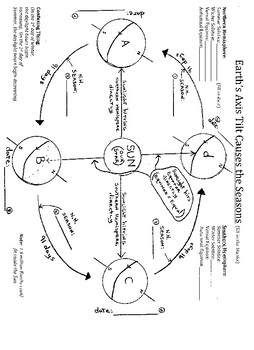
Equinox, Solstice, and Seasons Tutorial and Worksheet
Contains:
1) tutorial picture (acts as a worksheet because there are blanks that need to be filled in. Teacher should provide solstice and equinox dates (provided) for that particular year (put on board and use them like a word bank)
2) worksheet
3) worksheet w/ answers
spring, summer, fall, winter, astronomy
Subjects:
Grades:
6th - 11th, Higher Education, Adult Education, Staff
Types:

Astronomy: Chapter 1 Our Location in the Universe (Premium PowerPoint 2013)
Astronomy: Chapter 1 Here and Now
PowerPoint Presentation (2013)*
*This presentation was created and designed to run with Microsoft PowerPoint 2013. Some of the features and animations may not be present if using older versions of Microsoft PowerPoint or other programs.
Outline: This presentation is designed to give a frame of reference of where we are in the Universe and the scale of the Universe.
Topics: our place from Earth to universe, field of View, scientific notation, planet, star, so
Subjects:
Grades:
8th - 12th, Higher Education

Earth's Motions Bundle w/Key
This bundles includes power point presentations and scaffolded/guided notes for all lessons which include: Earth's Rotation, Earth's Revolution, and Celestial Sphere. Altitude of the Noon Sun lab/activity/investigation and Rotation Revolution Exam. Bonus: sun's path diagram worksheet which can be used in addition to the celestial sphere lesson or a springboard from the lesson. It has 15 questions following the activity. Kindly leave a review of my work, it will help me create future products.
Subjects:
Grades:
6th - 12th, Higher Education, Adult Education, Staff
Types:
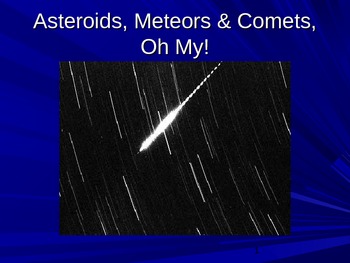
PowerPoint: Asteroids, Meteors & Comets Oh My!
Based on the California State Science Standards, this presentation goes over the differences between asteroids, meteors and comets. Students will learn where the asteroid belt is located and why it is there. Students will learn the difference between meteors, meteoroids, and meteorites along with how big the average meteor that lights up the night sky is.
This presentation also covers impacts such as the Tanguska Event in Siberia and the meteorite that caused the ultimate demise of the dinosa
Subjects:
Grades:
6th - 12th, Higher Education
Also included in: Astronomy

Question Exploration: How Did the Moon Form? GIANT IMPACT!
What are the violent origins of the Moon? The most widely accepted scenario for the formation of the Earth–Moon system involves a dramatic collision between the early Earth and some other cosmic body, with the present-day Moon thought to have coalesced from the debris ejected by a giant impact. This Question Exploration helps Ss explore the Giant Impact Theory of lunar formation.The first FRAME is a concept comparison among our Moon Luna, Mars' moons Phobos and Deimos, and the six largest natura
Subjects:
Grades:
8th - 12th, Higher Education
NGSS:
MS-ESS1-4
, HS-ESS1-6
, HS-ESS1-4
, HS-ESS1-5
Also included in: StayGiant Earth Science Bundle: Astronomy (space exploration)
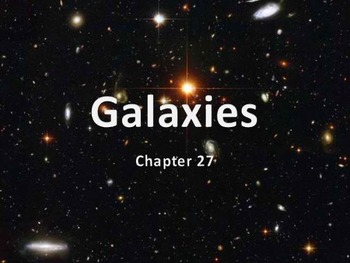
Astronomy: Types of Galaxies
Astronomy: Galaxies
PowerPoint Presentation
Topics: Galaxies, Thomas Wright, Immanuel Kant, William Parsons, V.M. Slipher, Edwin Hubble, Hubble classification, tuning-fork diagram, elliptical galaxies, elliptical geometry, normal and barred-spiral galaxies, population I and II stars, irregular galaxies, Messier objects, starburst galaxies
Subjects:
Grades:
9th - 12th, Higher Education
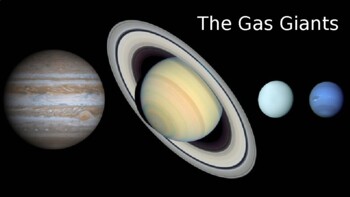
The Gas Giants: Saturn and Jupiter
This presentation covers the gas giant planets Jupiter and Saturn. There are 5 hyperlinks to Flybys and animations. The lesson has the most up to date stunning photography, animations and facts. There is a lot of detail covered such as size comparison, planetary facts, ring systems, atmospheres, interiors, aurora and much more! You may edit as necessary.The moons are covered here but go in much greater detail in another presentation.Please download the FREE follow along note sheet offered in
Subjects:
Grades:
6th - 12th, Higher Education
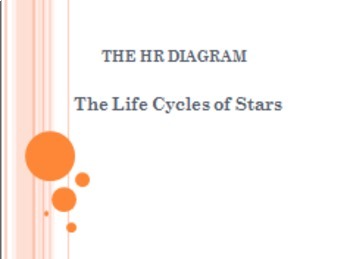
HR Diagram and Life Cycle of a Star PowerPoint
This lecture/notes based PowerPoint will teach the students about the HR Diagram and the properties that it graphs. They will also learn about the sections of the HR Diagram. The second part will teach them about the life cycle of a star and the process that low and medium mass stars go through, and then high mass stars. It also describes the process of the stars Death depending on their mass.
Subjects:
Grades:
7th - 12th, Higher Education
NGSS:
HS-ESS1-3
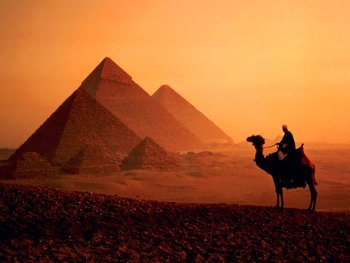
Astronomy Lectures - Chapter 1. "Ancient Astronomy"
This lesson deals with the birth of Astronomy from Mesopotamia to Aristotle, Ptolemy and the Roman Empire. Constellations, the Zodiac and birth of astrology, Pythagoras and the geo-centric theory are all discussed. The lesson is part of a series of lectures in various Astronomy topics that are useful for science teachers to supplement their lesson plans.
Subjects:
Grades:
1st - 12th, Higher Education, Adult Education
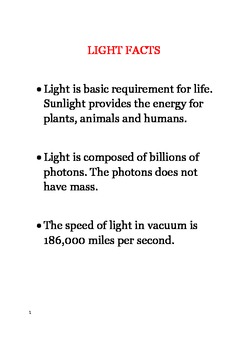
Light Facts - Light wave, sun light, speed of light, bulbs, photons
There are 95 facts about light. These are interesting facts about light wave, sun light, speed of light, bulbs, photons, lightning, tungsten, reflection, refraction, ultraviolet, infrared and more..
Light Facts by Jega Chinna is licensed under a Creative Commons Attribution-NonCommercial-NoDerivs 3.0 Unported License.
Subjects:
Grades:
3rd - 12th, Higher Education, Adult Education, Staff
Types:
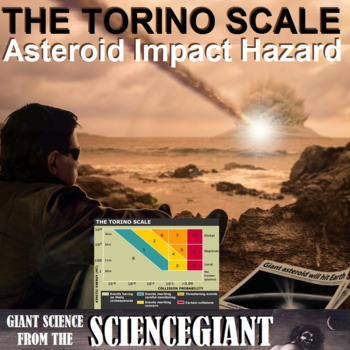
Concept Compare: Small Solar System Bodies (Comets, Asteroid, and Meteors)
A shooting star is not a star - it's not a "star" at all.A shooting star's a meteor, heading for a fall!This Concept Comparisons consists of three Frame Routines to help Ss contrast comets, asteroids, meteoroids, meteors, and meteorites. The final Frame contrasts types of meteorites: stony, iron, and stony-iron. The middle asks the Essential Question: How serious does an asteroid threat have to be before action is taken? To help communicate the hazard, the Torino Impact Hazard Scale assigns an i
Subjects:
Grades:
8th - 12th, Higher Education
Also included in: StayGiant Earth Science Bundle: Astronomy (space exploration)
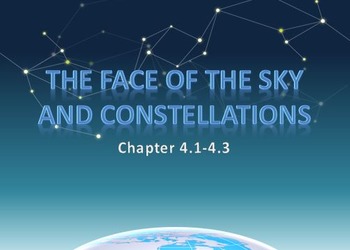
Astronomy: The Face of the Sky and Constellations
Astronomy: The Face of the Sky and Constellations
PowerPoint Presentation
Topics: Ancient and Modern Constellations, Greece and Mesopotamia, the Zodiac, Asterisms, Orion, the Great Bears, Eudoxus, Aratos, Hipparchus, Ptolemy
Subjects:
Grades:
9th - 12th, Higher Education
Showing 1-24 of 109 results





